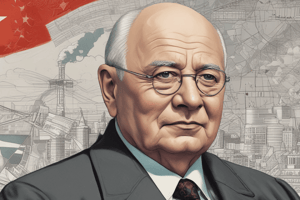Podcast
Questions and Answers
What was the role of the General Secretary in the USSR's political system?
What was the role of the General Secretary in the USSR's political system?
The General Secretary was the most powerful figure, overseeing the government and military.
How did the Soviet Union’s planned economy differ from a market economy?
How did the Soviet Union’s planned economy differ from a market economy?
In a planned economy, the state controls production, distribution, and prices, whereas a market economy relies on supply and demand.
What were the main characteristics of the bureaucratic apparatus known as the nomenklatura?
What were the main characteristics of the bureaucratic apparatus known as the nomenklatura?
The nomenklatura was a vast bureaucratic system that managed state administration and ensured loyalty to the Communist Party.
What was the impact of collectivization on Soviet agriculture?
What was the impact of collectivization on Soviet agriculture?
What economic challenges did the Soviet Union face in the late 1970s?
What economic challenges did the Soviet Union face in the late 1970s?
What was Gorbachev's main recognition upon assuming power as General Secretary?
What was Gorbachev's main recognition upon assuming power as General Secretary?
How did military spending affect the Soviet economy?
How did military spending affect the Soviet economy?
What role did the absence of market competition play in the Soviet Union's economic performance?
What role did the absence of market competition play in the Soviet Union's economic performance?
What were the main goals of the Bretton Woods Conference in 1944?
What were the main goals of the Bretton Woods Conference in 1944?
How did the US dollar function as the world's reserve currency under the gold standard?
How did the US dollar function as the world's reserve currency under the gold standard?
What was a key outcome of the US intervention in Iraq in 2003?
What was a key outcome of the US intervention in Iraq in 2003?
What were the main goals of Perestroika in the Soviet Union?
What were the main goals of Perestroika in the Soviet Union?
What role did the International Monetary Fund (IMF) play according to the Bretton Woods system?
What role did the International Monetary Fund (IMF) play according to the Bretton Woods system?
What is globalization and what are its primary drivers?
What is globalization and what are its primary drivers?
How did Glasnost change the landscape of information and discourse in the Soviet Union?
How did Glasnost change the landscape of information and discourse in the Soviet Union?
How has globalization contributed to economic inequality?
How has globalization contributed to economic inequality?
What political reforms were introduced under the concept of Democratisation?
What political reforms were introduced under the concept of Democratisation?
What was the impact of the US pivot to Asia in response to China's rise?
What was the impact of the US pivot to Asia in response to China's rise?
What was Gorbachev's 'New Thinking' in foreign policy, and what key initiatives did it involve?
What was Gorbachev's 'New Thinking' in foreign policy, and what key initiatives did it involve?
What challenges did Gorbachev face in implementing the economic reforms of Perestroika?
What challenges did Gorbachev face in implementing the economic reforms of Perestroika?
What were the key activities and goals of the US during the War on Terror?
What were the key activities and goals of the US during the War on Terror?
How did increased openness under Glasnost lead to political unrest within the Soviet Union?
How did increased openness under Glasnost lead to political unrest within the Soviet Union?
What impact did the end of the Cold War have on conflicts in Africa?
What impact did the end of the Cold War have on conflicts in Africa?
How did the collapse of the USSR in 1991 signify a turning point in global politics?
How did the collapse of the USSR in 1991 signify a turning point in global politics?
What are the main concerns associated with cultural homogenisation due to globalization?
What are the main concerns associated with cultural homogenisation due to globalization?
How has globalization challenged traditional notions of national sovereignty?
How has globalization challenged traditional notions of national sovereignty?
What role do institutions like the United Nations and WTO play in global governance?
What role do institutions like the United Nations and WTO play in global governance?
What are the key features of neoliberalism that have emerged since the 1980s?
What are the key features of neoliberalism that have emerged since the 1980s?
What criticisms do critics have regarding the impact of capitalism on society?
What criticisms do critics have regarding the impact of capitalism on society?
How have the IMF and World Bank's structural adjustment programs been perceived in developing countries?
How have the IMF and World Bank's structural adjustment programs been perceived in developing countries?
What characterized the geopolitical landscape during the post-WWII era?
What characterized the geopolitical landscape during the post-WWII era?
What defines the current dynamics of US-China rivalry in the global order?
What defines the current dynamics of US-China rivalry in the global order?
What key roles did Nelson Mandela and F.W. de Klerk play in South Africa's transition from apartheid?
What key roles did Nelson Mandela and F.W. de Klerk play in South Africa's transition from apartheid?
What was the significance of the Truth and Reconciliation Commission (TRC) in post-apartheid South Africa?
What was the significance of the Truth and Reconciliation Commission (TRC) in post-apartheid South Africa?
What were the main objectives of the Reconstruction and Development Programme (RDP)?
What were the main objectives of the Reconstruction and Development Programme (RDP)?
How did South Africa's apartheid-era debts impact the new government's social spending capabilities?
How did South Africa's apartheid-era debts impact the new government's social spending capabilities?
What were the main criticisms directed towards the Growth, Employment, and Redistribution (GEAR) policy?
What were the main criticisms directed towards the Growth, Employment, and Redistribution (GEAR) policy?
What were some of the key achievements of the South African government post-apartheid?
What were some of the key achievements of the South African government post-apartheid?
What challenges did South Africa face after the transition from apartheid despite the peaceful process?
What challenges did South Africa face after the transition from apartheid despite the peaceful process?
How did the 1994 elections symbolize a shift in South Africa's political landscape?
How did the 1994 elections symbolize a shift in South Africa's political landscape?
Flashcards are hidden until you start studying
Study Notes
The Soviet Union's political and economic system
- The Soviet Union was a one-party state ruled by the Communist Party of the Soviet Union (CPSU).
- The state controlled all aspects of life, including the economy, media, and education.
- The Soviet Union had a centrally planned economy, where the state controlled production, distribution, and prices.
- The USSR's economy was characterized by slow growth, inefficiency, and technological backwardness.
- The focus on military spending and heavy industry left little room for consumer goods, leading to poor living standards.
Gorbachev's reforms
- Mikhail Gorbachev, the General Secretary of the CPSU, introduced reforms aimed at addressing economic stagnation and political inefficiencies.
- Perestroika: Restructuring the economy, introducing elements of market mechanisms, and reducing central planning.
- Glasnost: Promoting transparency and freedom of information, leading to increased media freedom and public discourse.
- Democratisation: Introduced political reforms to increase participation, reducing the monopoly of the Communist Party.
- These reforms faced resistance from hardliners within the CPSU and bureaucratic inertia.
- The reforms contributed to the dissolution of the Soviet Union in 1991, ending the Cold War.
The end of the Cold War’s impact on South Africa
- The end of the Cold War reduced East-West tensions and shifted global power dynamics.
- It ended ideological conflicts supported by either the US or the USSR.
- South Africa was a key beneficiary of this shift, as it facilitated the end of Apartheid.
- The US involvement in global conflict was a defining factor in the 21st century, with the US leading the war on terror following 9/11.
Bretton Woods Conference
- The 1944 Bretton Woods Conference aimed to establish a framework for international economic cooperation.
- It established the International Monetary Fund (IMF) and the World Bank.
- The US dollar was linked to gold, serving as the reserve currency.
- The Bretton Woods system collapsed in the 1970s.
Globalisation
- Globalisation is the interconnection of economies, cultures, and populations worldwide.
- It has been driven by advances in transportation and communication technology.
- Globalisation has spurred economic growth and development but also contributed to rising income inequality.
- It has led to cultural exchange and diversity, albeit with concerns about cultural homogenisation.
- Globalisation challenges national sovereignty and fosters global governance.
The global dominance of Western capitalism
- Western capitalism characterized by free markets and private enterprise expanded globally after WWII.
- Neoliberal policies since the 1980s emphasized deregulation, privatization, and free trade.
- Capitalism is criticized for prioritizing profit over social and environmental concerns.
- It's also blamed for inequality, exploitation, and environmental degradation.
The global balance of power
- The Cold War era was characterized by a bipolar power structure between the US and Soviet Union.
- After the collapse of the Soviet Union, the US became the sole superpower, marking a unipolar world order.
- Emerging powers like China, India, and Russia have challenged US dominance.
- This has led to a more multipolar world, increasing the power of regional powers.
- The US-China rivalry defines the current global order.
South Africa's transition from Apartheid
- The apartheid system faced increasing resistance and international pressure.
- Nelson Mandela and F.W. de Klerk played crucial roles in negotiating a peaceful transition.
- Multi-party negotiations led to the dismantling of apartheid and the drafting of a new democratic constitution.
- The first democratic elections took place in 1994, with the ANC winning and Mandela becoming president.
- The Truth and Reconciliation Commission (TRC) was established to address past human rights abuses.
South Africa's debt, the RDP and GEAR
- South Africa inherited significant debt from the apartheid regime.
- The Reconstruction and Development Programme (RDP) aimed to address socio-economic inequalities by focusing on infrastructure development, job creation, and essential services.
- The Growth, Employment, and Redistribution (GEAR) policy introduced in 1996 focused on economic growth, fiscal discipline, and job creation but was criticised for prioritizing growth over social development.
- Despite progress in housing, education, and healthcare, South Africa faces challenges like corruption, inefficiency, and slow economic growth.
Studying That Suits You
Use AI to generate personalized quizzes and flashcards to suit your learning preferences.




